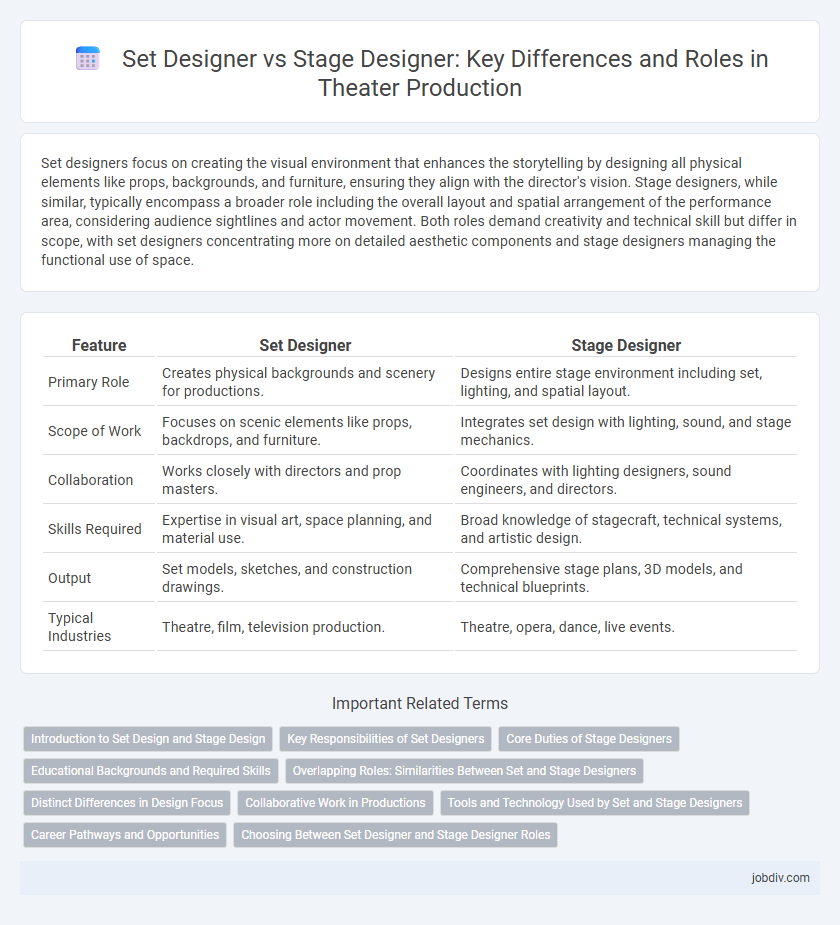Set designers focus on creating the visual environment that enhances the storytelling by designing all physical elements like props, backgrounds, and furniture, ensuring they align with the director's vision. Stage designers, while similar, typically encompass a broader role including the overall layout and spatial arrangement of the performance area, considering audience sightlines and actor movement. Both roles demand creativity and technical skill but differ in scope, with set designers concentrating more on detailed aesthetic components and stage designers managing the functional use of space.
Table of Comparison
| Feature | Set Designer | Stage Designer |
|---|---|---|
| Primary Role | Creates physical backgrounds and scenery for productions. | Designs entire stage environment including set, lighting, and spatial layout. |
| Scope of Work | Focuses on scenic elements like props, backdrops, and furniture. | Integrates set design with lighting, sound, and stage mechanics. |
| Collaboration | Works closely with directors and prop masters. | Coordinates with lighting designers, sound engineers, and directors. |
| Skills Required | Expertise in visual art, space planning, and material use. | Broad knowledge of stagecraft, technical systems, and artistic design. |
| Output | Set models, sketches, and construction drawings. | Comprehensive stage plans, 3D models, and technical blueprints. |
| Typical Industries | Theatre, film, television production. | Theatre, opera, dance, live events. |
Introduction to Set Design and Stage Design
Set design involves creating the physical surroundings on stage, including scenery, props, and backdrops that establish the environment for a production. Stage design encompasses the broader spatial arrangement, integrating lighting, sound, and actor movement to enhance the narrative and audience experience. Both disciplines collaborate to transform a script into a tangible visual and sensory atmosphere that supports storytelling.
Key Responsibilities of Set Designers
Set designers primarily focus on creating the visual environment of a production, designing detailed backdrops, props, and spatial arrangements that support the narrative. They collaborate closely with directors and lighting designers to ensure the set enhances mood and storytelling while maintaining functionality and safety. Unlike stage designers, whose role may encompass broader aspects like choreography of space and movement, set designers concentrate on the aesthetic and practical elements of the physical scenery.
Core Duties of Stage Designers
Stage designers specialize in creating the visual environment of a theatrical production, focusing on set layout, lighting integration, and spatial dynamics to enhance storytelling. They collaborate closely with directors and lighting designers to ensure the stage transforms fluidly between scenes while supporting actors' movement and audience sightlines. Their core duties include drafting detailed plans, selecting materials, and overseeing the physical construction or digital visualization of stage elements.
Educational Backgrounds and Required Skills
Set designers typically hold degrees in theater design, fine arts, or architecture, emphasizing creativity in visual storytelling and technical drawing, while stage designers often pursue education in theater production or performance technology, focusing on spatial arrangement and lighting coordination. Both roles require strong collaboration skills, an understanding of materials and construction techniques, and proficiency with design software such as AutoCAD or SketchUp. Practical experience through internships or apprenticeships in theater productions significantly enhances skills in set and stage design.
Overlapping Roles: Similarities Between Set and Stage Designers
Set designers and stage designers share core responsibilities including conceptualizing visual environments that support narrative storytelling and enhance audience immersion. Both roles require expertise in spatial planning, material selection, and collaboration with directors to ensure cohesive production aesthetics. Their overlapping skills emphasize creating functional, flexible spaces that accommodate performance needs and technical requirements.
Distinct Differences in Design Focus
Set designers concentrate on creating the physical environment of a production, emphasizing architectural elements, spatial layout, and visual aesthetics to enhance storytelling. Stage designers, however, focus more broadly on the overall stage composition, integrating lighting, sound, and scenic elements to ensure cohesive performance dynamics. The key difference lies in set designers' specialization on tangible structures versus stage designers' holistic approach to the entire performance area.
Collaborative Work in Productions
Set designers and stage designers collaborate closely to create immersive environments that enhance theatrical productions. While set designers focus on crafting physical backgrounds and props, stage designers integrate lighting, space utilization, and audience sightlines to ensure a cohesive visual narrative. Their coordinated efforts result in seamless transitions and compelling storytelling that elevate the overall production quality.
Tools and Technology Used by Set and Stage Designers
Set designers utilize advanced 3D modeling software such as AutoCAD and SketchUp to create detailed digital renderings of scenery, enabling precise spatial planning and visualization. Stage designers often combine traditional drafting tools with software like Vectorworks Spotlight, specialized for theater lighting and set coordination, ensuring seamless integration of technical elements. Both roles increasingly incorporate virtual reality (VR) technology to simulate stage environments, enhancing collaboration and design accuracy in live performance settings.
Career Pathways and Opportunities
Set designers specialize in creating detailed visual environments for film, television, and theater, often collaborating closely with directors and costume designers to ensure cohesive aesthetics. Stage designers focus primarily on live theater productions, crafting functional and dynamic spaces that support actors' performances and audience engagement. Career pathways for set designers often lead into film and TV production studios or freelance opportunities, while stage designers frequently find roles in theater companies, opera houses, or academic institutions.
Choosing Between Set Designer and Stage Designer Roles
Choosing between a set designer and a stage designer role depends on the scope of creative responsibilities and project scale. Set designers focus primarily on creating physical scenery and props that align with the director's vision, emphasizing detailed spatial layouts and material selection. Stage designers take a broader approach, integrating lighting, sound, and costume coordination to ensure a cohesive visual and atmospheric environment for live performances.
Set Designer vs Stage Designer Infographic

 jobdiv.com
jobdiv.com